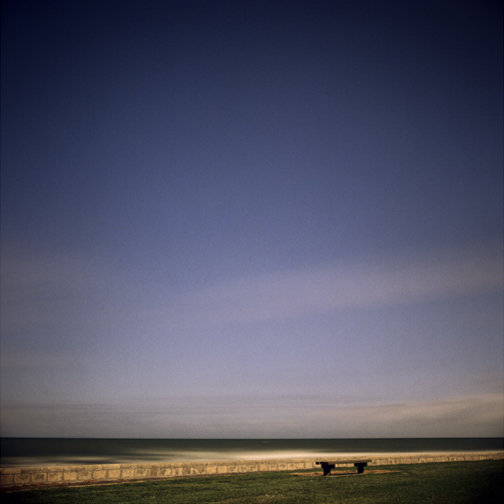In Park, HongChun’s photographs, we feel a sense of fading so that we can hardly keep our eyes open. The endless blue sky, the straight horizon meeting it, lonely seaside benches and pathways: Above them, lyricism flits like the wind.
The exhibition Trace of young photographer Park, HongChun, being held at the Samtuh Gallery in ChungDamDong, Seoul, is filled with photographs of landscapes that evoke a meditation. The works include 30 medium-large photographs taken in Sydney and Melbourne, Australia, from last fall through this summer. The artist calls forth sentiments―memories of someone who has left and loneliness―through landscapes of the sea that are infused with muted and washed-out colors.
All the works are photographs that were ‘elaborated’ by using a long exposure of more than 30 minutes. Unlike other photographers who emphasize the coincidence of capturing the moment when the shutter is released, Park HongChun believes he can obtain more unexpected images when he leaves his lens open ‘long’ because nature experiences abrupt changes, even during the taking of photographs, he says. Indeed, in some photographs, faint white traces appear around the bench or the pathway―the after-images of people who happen to come into the frame of his camera while he is photographing. Since the artist leaves his lens open so long, moving objects are transformed into blurred images, and the screen is refined as time goes by. The wraith-like figures of people and streaks of clouds illustrate the constant passage of time and function as props that represent the transience of human life.
|
|
Basically, Park, HongChun is an artist who takes photographs with a critical perspective on civilization. Through photographs of central Tokyo taken in the late 1980s and the series To Alice―photographs of Seoulland exhibited in the Kwangju Biennale this year―he has explored an illusion of modern civilization in which humanity has disappeared. But why does he present these lyrical landscapes?
Behind them are memories of his mother, who suddenly passed away on the bus to Seoul to visit him when he was a university student. The artist confesses, “After taking unfamiliar landscapes of the sea far away from home, I realized her absence and felt a strong longing for her.” The photographs are also relevant to his desire to fully feel real human emotions in our complicated world. In this sense, the vacant bench that appears frequently in his photographs is a tool that evokes the traces of people who once sat there. The paleness of the sky imbued with blood red, as well as the simple and minimal composition, is another allure of Park, HongChun’s photography. The distorted colors, which are created by the long exposures, convey a feeling of illness, “as if faded and corroded by time,” as photography critic Kim, SeungGon said. In the end, Park, HongChun’s photographs, in which the nostalgic image of the sky and the sea combines with human thoughts on the axis of time, may be read not through eyes, but through minds.
Through Oct. 9
- from The Hangyoreh, Sept. 29. 1997.
|
